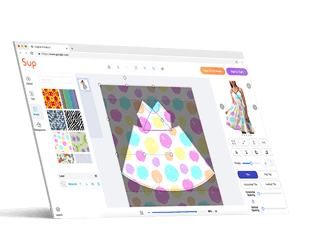الدروبشيبينغ الرقمي: دليل شامل (2025)

ربما سمعت بالفعل عن الدروب شيبنج. ولكن هل سمعت أيضًا عن منتجها الجديد "الدروب شيبنج الرقمي"؟
يتضمن نموذج العمل هذا شحن البضائع الرقمية غير الملموسة التي لا توجد إلا افتراضيًا بدلاً من المنتجات المادية الكلاسيكية.
للوهلة الأولى، قد تعتقد أن هذا العمل غير مربح. لكن فكر في الأمر - يستهلك الجميع تقريبًا بعض أشكال المنتجات الرقمية اليوم، لذا فمن المؤكد أن هناك إمكانية لتحقيق أرباح من هذا النموذج التجاري.
تغطي هذه المقالة كل ما عليك معرفته حول الدروبشيبينغ الرقمي، بما في ذلك الخطوات الدقيقة لبدء هذا العمل عبر الإنترنت وإيجابياته وسلبياته.
ما هو الدروبشيبينغ الرقمي؟
لفهم الدروبشيبينغ الرقمي، يجب عليك أولاً فهم مفهوم الدروبشيبينغ الأصلي — الشحن المباشر التقليديإذا كنت تعرف أي شيء عن التجارة الإلكترونية، فمن المرجح أنك سمعت بالفعل عن نموذج الأعمال هذا.
ولكن للتلخيص بإيجاز، فإن دروبشيبينغ هو نموذج أعمال منخفض المخاطر للغاية حيث تقوم بإدراج المنتجات على متجرك عبر الإنترنت، وعندما تصل الطلبات، يقوم الموردون لديك بشحن المنتجات المادية مباشرة إلى عملائك.
باعتبارك موزعًا مباشرًا، سوف تكسب من خلال هوامش الربح التي تحددها فوق سعر المورد دون الحاجة إلى الاحتفاظ بالمخزون أو إدارة تنفيذ الطلبات.
والآن، ماذا عن الدروبشيبينغ الرقمي؟
ببساطة، هذا هو النموذج الرقمي لنموذج الدروبشيبينغ التقليدي.
بدلاً من إدراج المنتجات المادية من الموردين الذين يحتاجون إلى شحنها عند تلقي الطلبات، يمكنك إدراج المنتجات الرقمية التي يمكن للموردين إرسالها إلى عملائك من خلال طرق مثل البريد الإلكتروني أو روابط التنزيل الفورية.
بالطبع، على غرار نظام دروبشيبينغ التقليدي، يمكنك أيضًا تحقيق الربح من خلال هوامش الربح التي تحددها فوق سعر المورد.
ما هي المنتجات الرقمية؟

كما يوحي الاسم، فإن المنتجات الرقمية هي سلع موجودة في شكل رقمي غير ملموس.
تشمل العناصر الشعبية التي تندرج ضمن هذه الفئة الكتب الإلكترونية، والدورات التدريبية عبر الإنترنت، والموسيقى، والبرامج، وألعاب الفيديو.
وتعتبر خدمات البث القائمة على الاشتراك مثل Netflix وSpotify Premium وAmazon Prime أيضًا منتجات رقمية، مما يثبت مدى شعبية المنتجات الرقمية في السوق اليوم.
كيفية البدء في الدروبشيبينغ الرقمي
الآن، لديك فكرة عامة عن ماهية الدروبشيبينغ الرقمي وكيفية عمله. ولكن كيف يمكنك على وجه التحديد بدء مشروع التجارة الإلكترونية هذا لكسب المال عبر الإنترنت؟
حسنًا، العملية أبسط كثيرًا مما تظن. لذا، دعني أشرح لك كيفية أن تصبح بائعًا رقميًا ناجحًا.
الخطوة 1: اختيار مكانة

قد يبدو بيع "المنتجات الرقمية" حصريًا بمثابة تخصص محدد بالفعل، ولكن عليك حقًا تضييق نطاق تركيزك بشكل أكبر إذا كنت تريد التميز في المنافسة في مجال التجارة الإلكترونية.
ببساطة، من الأفضل اختيار صناعة محددة أو نوع منتج أنت مهتم به ويكون مربحًا ثم تقديم المنتجات الرقمية التي تلبي هذا التخصص فقط.
تخيل هذا السيناريو: يحتاج المستهلك إلى شراء صور فوتوغرافية لمشروع يقوم به.
في النهاية، يتعين عليه الاختيار بين متجرين للتجارة الإلكترونية - أحدهما يبيع جميع أنواع المنتجات الرقمية، من الكتب الإلكترونية والدورات التدريبية عبر الإنترنت إلى الصور الفوتوغرافية، والآخر يركز فقط على بيع الصور الفوتوغرافية.
في أغلب الأحيان، سوف يختار الخيار الأخير.
يرجع ذلك إلى أنه بشكل عام، يكون من الأسهل بكثير الشراء من شخص تعتبره خبيرًا بناءً على عروض منتجاته و/أو مراجعات العملاء.
طريقتان لتوسيع نطاقك في مجال الدروبشيبينغ الرقمي
في دروبشيبينغ التقليدي، تحديد مكانة يشير هذا المصطلح عادةً إلى التركيز على صناعة معينة. على سبيل المثال، يمكنك إما إنشاء متجر للأزياء والجمال أو متجر مخصص لخبراء اللياقة البدنية.
في دروبشيبينغ الرقمي، على الرغم من ذلك، سيتم إعطاؤك طريقتين للتركيز على شيء محدد.
نعم، لا يزال بإمكانك التركيز على صناعة معينة. ومع ذلك، فإن العديد من متاجر دروبشيبينغ الرقمية تركز أيضًا على نوع منتج واحد. لقد رأيت متاجر للتجارة الإلكترونية تبيع دورات تدريبية عبر الإنترنت حصريًا، على سبيل المثال، ومتجرًا آخر يبيع فقط إعدادات مسبقة لتصنيف الألوان لمقاطع الفيديو.
ومع ذلك، خذ وقتك في التفكير في كيفية التركيز على مجال عملك واتبع هذا المجال بينما تنتقل إلى بقية الخطوات أدناه.
الخطوة 2: تحديد المنتجات الرقمية التي تريد بيعها
إذا قررت التركيز على نوع معين من المنتجات، فإن هذه الخطوة ستكون سهلة للغاية. إذا كنت تريد بيع الكتب الإلكترونية، على سبيل المثال، فما عليك سوى معرفة أنواع الكتب الإلكترونية الأكثر طلبًا أو الرائجة أو التي تتمتع بقيمة محتملة، ثم انتقل إلى الخطوة التالية.
ومع ذلك، إذا اخترت التركيز على صناعة معينة، فإن هذه الخطوة سوف تتطلب المزيد من الجهد.
أولاً، عليك أن تفهم احتياجات السوق المستهدفة ضمن الصناعة التي اخترتها.
بعد ذلك، من خلال البحث المكثف أو تحليل المنافسين، يجب عليك معرفة المنتجات الرقمية المحتملة التي قد تحل مشكلة أو تلبي احتياج سوقك المستهدف.
وأخيرًا، من بين المنتجات الرقمية ذات الصلة بمجالك، يجب عليك تحديد تلك التي يمكنها توليد المبيعات.
الخطوة 3: البحث عن موردي المنتجات الرقمية

في هذه المرحلة، ربما تعرف بالضبط ما تريد بيعه، ولكنك لا تزال لا تتمتع بإمكانية الوصول إلى هذه المنتجات بعد.
لذا، حان الوقت للعثور على موردي المنتجات الرقمية الذين يقدمون بالضبط أنواع المنتجات التي لديك في ذهنك.
الآن، انتبه جيدًا - لن يكون العثور على موردي دروبشيبينغ الرقميين سهلاً مثل العثور على الموردين في دروبشيبينغ التقليدي. وذلك لأن المنتجات الملموسة، لأسباب واضحة، مطلوبة بشكل أكبر، مما يؤدي إلى زيادة المنافسة بين الموردين.
لكن لا تقلق؛ فهذا لا يعني أن العملية ستكون الذي - التي صعب.
الطريقة الأسهل للعثور على موردي المنتجات الرقمية هي زيارة الأسواق عبر الإنترنت مثل Etsy وGumroad وAmazon. بمجرد دخولك إلى هذه المنصات، ما عليك سوى البحث عن المنتجات الرقمية المحددة التي تنوي بيعها للعثور على المتاجر التي توفرها.
وبدلاً من ذلك، يمكنك البحث مباشرةً عن كل منتج رقمي تريد بيعه باستخدام محرك بحث مثل Google للعثور على المبدعين الأصليين لتلك المنتجات.
بمجرد العثور على الموردين ذوي الخبرة والموثوقين والذين لديهم تقييمات ممتازة، قم بإبلاغهم بنيتك في عرض منتجاتهم على متجر دروبشيبينغ الرقمي الخاص بك.
من المهم للغاية الحصول على إذنهم، حيث إن بعض منشئي المنتجات الرقمية قد لا يوافقون على قيام الآخرين بإعادة بيع أعمالهم.
ملحوظة: في مجال الدروبشيبينغ الرقمي، من الشائع جدًا أن يكون لديك العديد من الموردين لمخزون الدروبشيبينغ الخاص بك. ففي السيناريو المتطرف للغاية، قد يتم إنشاء كل منتج من منتجاتك بواسطة مورد مختلف.
الخطوة 4: إعداد متجرك
ربما تتساءل: كيف أقوم بالضبط بإعداد متجر للسلع غير الملموسة؟
حسنًا، إنه في الواقع لا يختلف كثيرًا عن إنشاء متجر عبر الإنترنت عادي للمنتجات الملموسة أيضًا.
تبدأ العملية عادةً باختيار المنصة التي تريد استضافة متجرك عبر الإنترنت عليها.
هل تتذكر أنه في السابق كان بإمكانك العثور على الموردين إما من خلال الأسواق عبر الإنترنت أو من خلال مواقع الويب؟
حسنًا، ينطبق نفس المفهوم عند إنشاء متجرك عبر الإنترنت. يمكنك إما البيع على الأسواق عبر الإنترنت مثل Etsy أو إنشاء موقع التجارة الإلكترونية الخاص بك باستخدام منشئي مواقع الويب مثل Shopify وWix وEcwid.
في الغالب، يعتمد هذا الاختيار على تفضيلاتك الشخصية.
ولكن إذا كنت ترغب في تعظيم فوائد الخطوة التالية، وهي إنشاء علامة تجاريةإذا كنت ترغب في إنشاء موقع ويب خاص بك، فإن القيام بذلك يوفر لك المزيد من خيارات التخصيص لتصميم متجرك وتدفقه وتجربة العملاء.
الخطوة 5: إنشاء العلامة التجارية

في دروبشيبينغ الرقمي، لن تتمكن من توفير ما يلي بالضبط التعبئة والتغليف المخصصة أو قم بوضع شعارك واسم علامتك التجارية على المنتجات الفعلية.
ومن ثم، فإن عملية بناء العلامة التجارية لمتاجر الدروبشيبينغ الرقمية غالبًا ما تركز على تخصيص تصميم متجرك، وتجربة العملاء التي تقدمها، وإجراء حملة تسويقية متسقة بدلاً من ذلك.
لكي نكون أكثر تحديدًا، إذا كنت تريد أن يكون لمتجر دروبشيبينغ الرقمي الخاص بك حضور قوي للعلامة التجارية، فمن الضروري أن:
- يجب أن يمثل اسم العلامة التجارية المنتج الذي تقدمه ومهمتك
- يتمتع الموقع الإلكتروني بلوحة ألوان وأسلوب تصميم متناسقين
- المنتجات مرتبطة بمجال واحد
إن العلامة التجارية ضرورية لأنها تبني الثقة بينك وبين عملائك وتسمح لهم برؤية متجرك كخبير يمكنه توفير وتسليم ودعم احتياجاتهم بشكل فعال.
الخطوة 6: تسويق علامتك التجارية ومنتجاتك

في أعمال التجارة الإلكترونية، يمكن لأي شخص تقريبًا حول العالم أن يصبح عميلاً لك.
لكن تخيل ماذا سيحدث - سيكون من المستحيل عليهم الشراء من متجرك إذا لم يكونوا على علم بوجوده في المقام الأول.
لذا، بقدر الإمكان، تسويق علامتك التجارية ومنتجاتها من خلال منصات التواصل الاجتماعي والمنتديات وأي قنوات أخرى ممكنة.
استنادًا إلى سنوات خبرتي في تدريب البائعين المباشرين الطموحين، أعلم أن التسويق ليس من أقوى المهارات التي يتمتع بها الجميع. ولكن لا داعي للقلق حتى لو كانت هذه هي حالتك أيضًا، فكل ما عليك فعله هو استثمار بعض الوقت في التعرف على استراتيجيات التسويق الحديثة عبر الإنترنت.
يمكنك اختيار دورات التسويق المدفوعة عبر الإنترنت، ولكن بصراحة - حتى الموارد المجانية في الوقت الحاضر أكثر من كافية لمساعدتك على النجاح في تسويق علامتك التجارية بنجاح.
البداية 7: البدء في تلقي الطلبات
عاجلاً أم آجلاً، سوف تصل إلى أفضل جزء من هذه العملية - كسب المال فعلياً!
بمجرد استلام طلب أحد العملاء، ستحتاج إلى نقل معلومات العميل والدفع إلى المورد المحدد لهذا المنتج، وبعد ذلك سيقوم المورد بتسليم المنتج الرقمي مباشرة إلى العميل.
لدى العديد من الموردين بالفعل نظام تنفيذ الطلبات الآلي، لذلك إذا قمت بوضع طلب باستخدام تفاصيل المشتري، فسيتلقى عميلك المنتج على الفور.
ومع ذلك، لا يزال هناك العديد من الموردين الذين يقومون بتنفيذ الطلبات يدويًا. إذا كنت تتعامل مع أحد الموردين، فقد يكون من الأفضل إبلاغ العملاء بأن الأمر قد يستغرق عدة ساعات أو وقتًا أطول قليلاً لتلقي رابط التنزيل للمنتجات التي طلبوها.
الخطوة 8: استمر في تحسين أعمال الدروبشيبينغ الرقمية الخاصة بك
كما أقول دائمًا لجميع الموردين الذين أقوم بتدريبهم، يجب أن تكون دائمًا متشوقًا لتحسين وتنمية أعمالك.
ابحث دائمًا عن ردود الفعل، البحث في اتجاهات السوق والمنافسين، وبذل قصارى جهدنا لإبهار العملاء حتى يكون لديهم دائمًا سبب للعودة مرة أخرى.
علاوة على ذلك، ابذل قصارى جهدك لضمان أن تكون مجموعة المنتجات في متجرك "حيوية" دائمًا.
وهذا يعني التأكد من أن منتجاتك تواكب أحدث الاتجاهات، وعدم الخوف من إزالة العناصر التي لا يتم بيعها بشكل جيد، والبحث دائمًا عن فرص المنتجات الجديدة التي قد تكون ذات صلة بعملائك.
إيجابيات وسلبيات الدروبشيبينغ الرقمي
هل تتساءل عن السبب الذي يجعل البيع المباشر عبر الإنترنت أحد أفضل المشاريع التي يمكنك البدء بها؟ دعنا نتناول ثلاثة من الأسباب الرئيسية.
تكاليف أولية قليلة أو معدومة

لا يختلف الدروبشيبينغ الرقمي عن الدروبشيبينغ التقليدي بمعنى أن تكاليفه الأولية قليلة أو معدومة. لن تحتاج إلى دفع أي أموال للموردين إلا عند استلام الطلبات، ولن تقلق بشأن أي تكاليف تتعلق بإتمام الطلبات.
التكاليف الوحيدة التي قد تحتاج إلى دفعها عند استخدام نظام الشحن المباشر الرقمي هي رسوم الاستضافة لإنشاء موقع الويب الخاص بك و/أو نفقات التسويق إذا كنت ترغب في الانتقال به إلى المستوى التالي. يمكن أن يصل مجموع كل من هذه التكاليف إلى $50 شهريًا، لذا فهي لا تزال أكثر تكلفة من نماذج الأعمال الأخرى.
القراءة ذات الصلة: ما هو Shopify وكيف يعمل؟ (دليل كامل)
لا يوجد استرداد أو استبدال
أذكر دائمًا أن أحد التحديات التي تواجه نظام الشحن المباشر التقليدي هو التعامل مع طلبات الإرجاع أو الاستبدال. وذلك لأن النفقات المترتبة على هذه الطلبات تقع في كثير من الأحيان على عاتق الموردين أنفسهم، وليس المورد.
ولكن لحسن الحظ، فإن عمليات استرداد الأموال أو الاستبدال تكون شبه معدومة في الشركات الصغيرة التي تقدم منتجات رقمية. فبمجرد أن يقوم العملاء بتنزيل نسخة من المنتج، لا يمكنهم إعادته.
الآن قد تفكر: "لكن انتظر - Netflix ومواقع البث الأخرى تقوم أحيانًا برد أموالك إذا لم تكن راضيًا، أليس كذلك؟"
حسنًا، هؤلاء هم أكبر اللاعبين في سوق المنتجات الرقمية. ولن يتوقع معظم العملاء نفس مستوى الخدمة من العلامات التجارية الأصغر في هذا المجال.
عمليات مبسطة
لا شك أن التوزيع الرقمي أسرع كثيرًا من التوزيع المادي للمنتجات. وإذا تعاونت بعناية مع الموردين المناسبين، فقد تتم هذه العملية بشكل فوري.
حتى لو كانت هناك تأخيرات طفيفة، فقد لا ينتظر عملاؤك أكثر من يوم واحد قبل أن يتمكنوا من استلام منتجاتهم. وفي عالم الأعمال، كلما قل وقت انتظار العملاء، كانت تجاربهم أفضل، وزادت احتمالية شرائهم مرة أخرى أو التوصية بك للآخرين.
سلبيات الدروبشيبينغ الرقمي
لا يقتصر البيع المباشر عبر الإنترنت على المزايا فقط، بل له أيضًا سلبياته، بما في ذلك ما يلي:
انخفاض الطلب
تندرج العديد من المنتجات المادية ضمن "احتياجات" المستهلكين، مما يعني أنه سيكون هناك دائمًا مستوى ثابت من الطلب على هذه المنتجات، وخاصة من سوقك المستهدف.
ولكن من المؤسف أن المنتجات الرقمية في المقابل غالباً ما تكون مجرد "رغبة" بالنسبة للعملاء. بطبيعة الحال، هناك بعض المنتجات الرقمية التي يحتاجها الناس بالفعل لأغراض محددة، مثل الموارد اللازمة لعملهم، أو تنظيم قوالب لحياتهم، أو تراخيص البرامج.
ومع ذلك، فإن العديد من المنتجات الرقمية، مثل الكتب الإلكترونية والدورات التدريبية، تلبي بشكل عام المزيد من احتياجات الترفيه، أو الفضول، أو غيرها من الاحتياجات غير الأساسية.
الاعتماد على الموردين
تعتمد جميع نماذج دروبشيبينغ بشكل كبير على الموردين. لذا، إذا أخطأ المورد في تنفيذ الجزء الخاص به من الصفقة، فسوف تتحمل أنت للأسف كل اللوم على العميل.
لهذا السبب، من الضروري اختيار شركة دروبشيبينغ موثوقة وذات خبرة عالية إذا كنت تريد أن تنجح علامتك التجارية في مجال الدروبشيبينغ الرقمي.
مخاطر القرصنة
بمجرد بيع منتج رقمي، يمكن بسهولة تكراره وتوزيعه، مما يعني أن هناك دائمًا خطرًا على المشتري إعادة التوزيع بشكل غير قانوني محتوى مورديك.
باعتبارك أحد موردي الشحن المباشر، يجب عليك تحديد شروط وأحكام متجرك بوضوح لضمان، أو على الأقل توضيح، أن العملاء يجب أن يستخدموا المنتجات التي اشتروها بأنفسهم فقط.
الأفكار النهائية حول الدروبشيبينغ الرقمي
يعد الدروبشيبينغ الرقمي أحد أسهل مشاريع التجارة الإلكترونية التي يمكن ممارستها، لأنه يتطلب الحد الأدنى من الاستثمار، ولا يتطلب إدارة المخزون، ولا ينطوي على متاعب الاسترداد والإرجاع.
ومع ذلك، قبل أن تقفز إلى فكرة العمل هذه، تأكد من أنك تفهم بالفعل كيفية عملها، وما هي إيجابياتها وسلبياتها، وما إذا كان لديك الوقت لشراء المنتجات الرقمية، والتفاوض مع الموردين، وتسويق متجرك.
تذكر: لا يوجد عمل سهل ومضمون.
إذا كنت تبحث عن المزيد من الفرص لكسب المال عبر الإنترنت بمخاطر مالية منخفضة للغاية، ففكر أيضًا في نموذج الدروبشيبينغ التقليدي.
كما ذكرنا سابقًا، سيكون الطلب على المنتجات المادية دائمًا أعلى في السوق، مما يعني أنه سيكون من الأسهل قليلاً تحقيق المبيعات عند بيعها.
هنا في Sup Dropshippingيسعد وكلاء دروبشيبينغ لدينا أن يرشدوك شخصيًا خلال عملية اختيار المنتج وتخصيص العلامة التجارية لمتجر دروبشيبينغ الخاص بك، بالإضافة إلى تقديم النصائح ذات الصلة التي يمكن أن تضمن النجاح على طول الطريق.
عن المؤلف

يمكن
ماي هي مدوّنة في Sup Dropshipping وتتمتع بخبرة تزيد عن 5 سنوات في مجال التجارة الإلكترونية. إن شغف ماي بالتجارة الإلكترونية يدفعها إلى البقاء على اطلاع بأحدث الاتجاهات ومشاركة خبراتها معك من خلال مدونتها. تحب في أوقات فراغها قراءة رواية أو الدردشة مع الأصدقاء.
6 ردود على "Digital Dropshipping: Comprehensive Guide (2025)"
-
إنه مثير للاهتمام حقًا.
-
مرحبًا، إذا كنت مهتمًا بإنشاء متجر عبر الإنترنت، فلا تتردد في قراءة فوائد مقالات مدونتنا.
-
-
أنا مهتم
-
صباح الخير، لا داعي لإنشاء حساب باستخدام Sup Dropshipping. يمكننا مساعدتك في العثور على جميع المنتجات التي لا تحتاجها.
-
-
أريد أن أستثمر
-
مرحبًا، يمكنك اتباع تعليماتنا في البريد للبدء في مشروعك التجاري الرقمي.
-





اترك تعليقاً